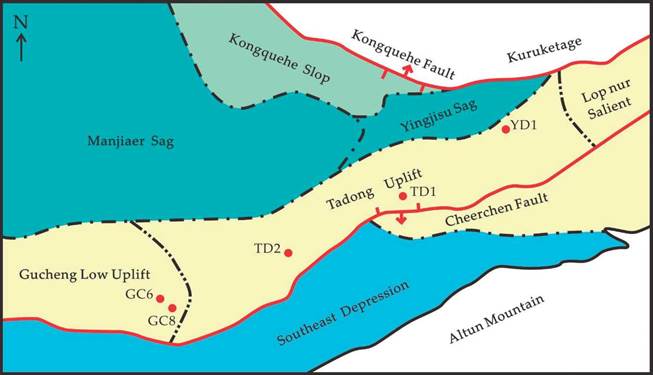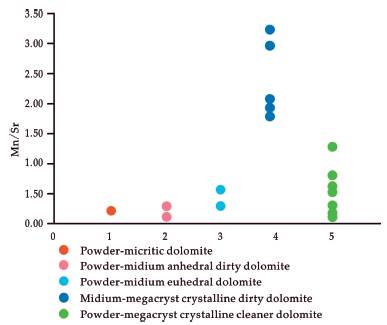Introduction
The hydrothermal process is an important geological function for the formation of a carbonate reservoir. Hydrothermal fluids change the characteristics of carbonate reservoir through dissolution, replacement, and filling (Davies & Smith, 2006; Luczaj, Harrison, & Williams, 2006; Smith, 2006; Sibley & Gregg, 1987). The typical hydrothermal carbonate reservoir has been found in the Sichuan basin and Tarim Basin (Jiao & Xing, 2011; Gu, 2000; Zhao et al., 2014; Huang & Liu, 2013; Zhang et al., 2009). At present in Tadong area Ordovician has become a key area of oil and gas exploration and development, the rock core reveals the influence of thermal fluid on the Ordovician reservoir in this area. The predecessors attached great importance to the hydrothermal activity in Tadong area. It is considered that the hydrothermal dolomitization and hydrothermal dissolution have important control effect on the transformation of carbonate reservoir (Ma et al., 2009; Shen et al. 2009; Zou et al., 2009; Jiao et al., 2011; Jin & Yu, 2011; Yu & Jin, 2010; Liu et al., 2008; Jin et al., 2012; Pan et al., 2009; Hu et al., 2009). In the process of evolution in Tarim Basin mainly experienced four important geological thermal events, respectively in the Sinian to Cambrian, Ordovician, Permian, and Cretaceous (Li et al., 2005; Chen et al., 1997; Wen & Wang, 2005; Yang & Xu, 2014). At present, the study of the hydrothermal effect on Ordovician carbonate in Tadong area is still in the initial stage, while the research of the hydrothermal activity patterns and mechanism is not deep enough. Based on the thin section, cathodoluminescence, carbon and oxygen isotope, trace element and rare earth elements analysis, this paper studies the hydrothermal process of Ordovician carbonate in Tadong area, establishes litho mineralogical and geochemical identification marks of the hydrothermal process. Also, it analyzes the mechanism of the hydrothermal process and its influence on the formation of reservoir space, which is significant for the understanding of the Ordovician dolomite and its reservoir genesis mechanism.
Regional geological background
The Tadong area is located in the eastern Tarim Basin, controlled by the Kongquehe fault and Cheerchen fault, divided into three tectonic units, namely northern depression, Tadong uplift, Southeast depression. The scope of this study area is Gucheng low uplift, Lop Nur Salient, and Tadong uplift (Figure 1). There are Cambrian to Ordovician carbonate in the area, according to the drilling results, lithology of the lower Ordovician Penglai dam group is grey limestone, and limestone-bearing dolomite, lithology of Yingshan section is gray dolomitic limestone and limestone bearing dolomite, with thin dolomite. The lithology of upper Yingshan to Yijianfang formation is gray granular limestone, Tumuxiuke formation is gray-brown argillaceous limestone. Charchag formation is a large set of grey mudstone, silty mudstone, and siltstone. The Tadong area has complex tectonic evolution history, there are multi-period big faults, as the main channel of hydrothermal fluid migration and diffusion, has a certain control effect on the hydrothermal dolomite and its dissolution transformation (Wu et al., 2011; Lu et al., 2006; Wu et al., 2009; Wu, He, & Sun, 2015; Han et al., 2009; Li et al, 2014; Jia et al., 1995). In recent years, oil and gas exploration in the Tadong area have a breakthrough; many exploration wells have obtained industrial gas flow in the Lower Palaeozoic Ordovician Dolomite sewn and cavern reservoirs. This paper reveals that the Ordovician carbonates are the potential oil and gas exploration strata and fields in the study area, and the hydrothermal dolomite provides an important reservoir space for oil and gas.
Identification mark of hydrothermal process
Petrology and mineralogy marks
According to the thin section and cathodoluminescence analysis technology, in Tadong area more than 200 thin section samples of Ordovician, 13 wells have analyzed and found that the Ordovician hydrothermal action formed various forms of dolomite; they can be medium-megacryst crystalline dirty dolomite (Figure 2a). The powder-megacryst crystalline cleaner dolomite (Figure 2b), medium-megacryst crystalline dirty dolomite patches and medium-megacryst crystalline cleaner dolomite patches in limestone. Under the cathode ray, the Ordovician hydrothermal dolomite is not luminescent or dark. It can be specific that medium-megacryst crystalline dirty dolomite dark rosy light (Figure 2a). Powder-megacryst crystalline cleaner dolomite is near no light (Figure 2b). No luminescence of medium-megacryst crystalline dolomite formed by recrystallization (Figure 2c); early high salinity formation dolomites, hydrothermal fracture pore cave and a saddle like dolomites dark rosy light (Figure 2d); dark rosy light from dolomite of the edge of the fracture pore cave (Figure 2e). The saddle-like dolomite in structural fractures is near to no light (Figure 2f).
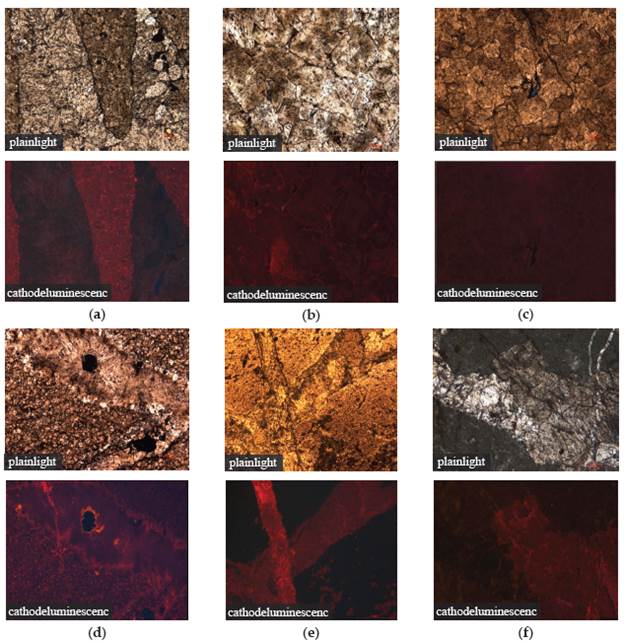
Figure 2 Mineralogy forms and cathodoluminescence features of the Ordovician hydrothermal process in Tadong area. (a) GC7, 6079m, medium-megacryst crystalline dirty dolomite, under the cathode ray, it is dark rosy light. (b) GC7, 6510m, powder-megacryst crystalline cleaner dolomite, under the cathode ray, it is near no light. (c)GC8,6065m, medium-megacryst crystalline dolomite formed by recrystallization, under the cathode ray, it is not luminescent. (d) YD1, 4980m, hydrothermal fracture pore cave and a saddle like dolomites, under the cathode ray, it is dark rosy light. (e) YD2,4390m, dolomite of the edge of the fracture pore cave, Under the cathode ray, it is dark rosy light. (f)GC7, 6087m, the saddle like dolomite in structural fractures, under the cathode ray, it is near to no light.
Geochemical characteristics and recovery of hydrothermal fluid properties
Subsubsection Characteristics of carbon and oxygen stable isotopes
The carbon and oxygen isotope analysis of 56 Ordovician Dolomite samples in the study area shows that the δ13C value and the δ18O value are relatively high. The δ13C value is -1.63~0.62 %0 PDB, the average value is -0.70%oPDB, the δ18O value is 4.69%0־~8.21־PDB, and the average value is -6.48%0 (Figure 3). Medium-megacryst crystalline dirty dolomite and powder-megacrysts crystalline cleaner dolomite is different, the former showed slightly lower δ18O values, δ18O values of -8.21~-6.25%0PDB, with an average of -7.05%oPDB; the latter showed slightly higher values of δ18O, δ18O value is -7.96~-4.69%0PDB, with an average of -5.94%0PDB (Figure 3).
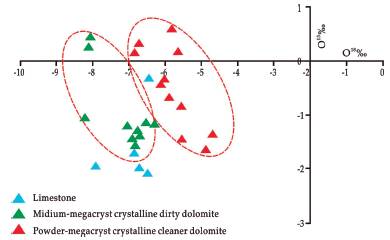
Figure 3 Carbon and oxygen isotopic characteristics of the Ordovician hydrothermal dolomite in Tadong area
Compared with the region and adjacent areas of Ordovician carbonate minerals δ180 values found that δ180 hydrothermal dolomite of Ordovician in Tadong was higher than that δ18O value of the non-reformed limestone in the region (6.48%0-~7.92־PDB, and the average value is 6.89%PDB)(Figure 4). It was also higher than the region Ordovician evaporation pump, seepage reflux, shallow burial of macrocrystalline dolomite, powder-fine crystalline anhedral dirty dolomite, powder-fine crystalline euhedral dolomite δ180 values (Figure 4). It was significantly higher than that of shallow buried powder-fine crystalline euhedral dolomite plaque δ180 value of Ordovician in northern Tarim Basin (6.80%-~9.47־oPDB, and the average value is -8.14%0PDB). Obviously, the Composition characteristics of Ordovician carbonate δ1O value in Tadong cannot be explained by the process that Ordovician formation water increases with burial deepened temperature. It is revealed that the source of the formation or transformation of dolomite is not the Ordovician, but it is related to the action of the external fluid.
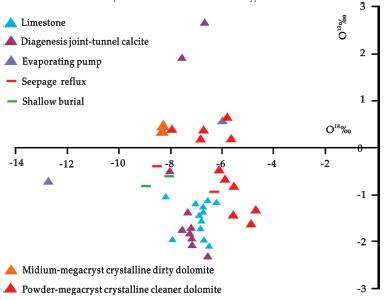
Figure 4 Carbon and oxygen stable isotopic composition characteristics of the Ordovician carbonate minerals in Tadong area
Through the test of homogenization temperature of fluid inclusions, homogenization temperature of salt-water inclusion of medium-megacryst crystalline dirty dolomite in the study area is 125.9~136.4°C; the average value is 131.15C, the δ180 value is -8.21~-6.25%0PDB. While homogenization temperature of salt-water inclusion of powder-megacrysts crystalline cleaner dolomite is 137.5~137.9C, the average value is 137.7C; the δ180 value is -7.96~-4.69%PDB. By the formula proposed in document (Land, 1983), the oxygen isotope value (SMOW) of the fluid can be calculated.
The oxygen isotope value (SMOW) in Formula 1 is the standard average seawater international standard. According to the formula recommended by the US investigation department (δ18OSMOW=1.03086δ18OPDB+30.86), it can be converted to the isotope PDB standard used in the above study.
The calculated results show that the δ18OSMOW value of the medium-megacryst crystalline dirty dolomite hydrothermal fluid is 4.95-6.94%, and the δ18OSMOW value of the powder- megacrysts crystalline cleaner dolomite is 5.81-9.13%. The comparative analysis shows that they reveal that the precipitated dolomite fluid is not brine derived from seawater or seawater. The δ180 value of brine is about -10% SMOW. The δ18O value of the sedimentary fluid forming medium-megacryst crystalline dirty dolomite is similar to the value (6.0±1.0%SMOW) of the primary water derived from the mantle-derived from the Taylor (1979) mantle, indicating that its diagenetic fluid may be the source of the basic magmatic-hydrothermal fluid. The value of the sedimentary fluid forming powder-megacrysts crystalline cleaner dolomite is similar to the value of granitic magma (6- 12% SMOW), revealing that its diagenetic fluid may be the source of acid magmatic-hydrothermal fluid.
Composition characteristics of trace elements
The analysis of trace elements in 23 Ordovician hydrothermal dolomite samples shows that there are obvious differences in trace element compositions between two dolomites, such as medium-megacryst crystalline dirty dolomite and powder-megacryst crystalline cleaner dolomite. Medium-megacryst crystalline dirty dolomite shows high Mn content, low Sr content, and high Mn/Sr ratio. The content of Mn is 134.1-255.1PPM; the average value is 183.72PPM, the Sr content is 74.89-106.3PPM; the average value is 87.11PPM, the Mn/ Sr ratio is 1.783-3.237; the average value is 2.132. The powder-megacryst crystalline cleaner dolomite and a saddle like dolomite showed low Mn content, high Sr content, and low Mn/Sr ratio. The content of Mn is 8.167-140.6PPM, the average value is 57.61PPM; the Sr content is 91.5-263.8PPM, the average value is 170.85PPM; the Mn/Sr ratio is 0.089-1.282, the average value is 0.36. The comparison of their trace elements with other types of dolomites is shown in Figure 5.
Combined with the characteristics of luminescent dark under the cathode ray of the hydrothermal dolomite, the Mn content of medium-megacryst crystalline dirty dolomite is high, suggesting that the content of Mn and Fe in the diagenetic fluid is high. It may have revealed that its diagenetic fluid has the properties of the basic magmatic-hydrothermal fluid. The Mn content of powder-megacryst crystalline cleaner dolomite is low, suggesting that the content of Mn in the diagenetic fluid is low. It may have revealed that the diagenetic fluids have the properties of acid magmatic hydrothermal fluids. This is in agreement with the results calculated by the δ180 value of the front fluid.
The characteristics of the composition of rare earth elements
The REE analysis of 20 Ordovician hydrothermal dolomites in the study area revealed that the composition of the rare earth elements of two types of dolomite in the area has formed. The total amount of rare earth elements in the medium-megacryst crystalline dirty dolomite is slightly higher than the total amount of the rare earth elements in the normal marine limestone. REE average value is about 1.63ppm. There is an obvious positive Eu anomaly, and the mean value of the δEu value is up to 1.445 (Figure 6). The powder- megacryst crystalline cleaner dolomite has higher total rare earth elements. REE between 6.737~23ppm. Relatively rich in light rare-earth elements and relatively poor in heavy rare earth elements, positive Ce anomaly, and negative Eu anomaly. The average value of the ratio of light rare earth elements to the content of heavy rare earth elements is 5.o. The average value is about 1.264ppm (Figure 7) . The characteristics of the saddle like dolomite and powder-megacryst crystalline cleaner dolomite are the same.
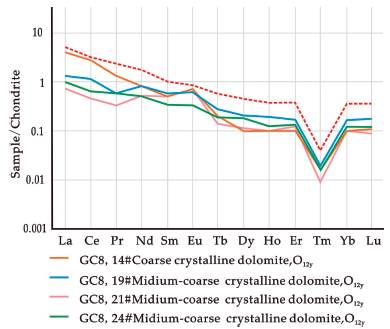
Figure 6 Distribution pattern of rare earth elements in the Ordovician medium-megacryst crystalline dirty dolomite
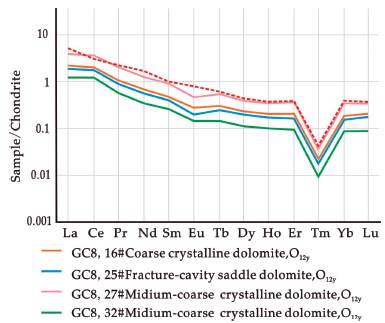
Figure 7 Distribution pattern of rare earth elements in the Ordovician powder-megacryst crystalline cleaner dolomite
Comparative analysis shows that the rare earth elements composition and distribution pattern of Ordovician medium-megacryst crystalline dirty dolomite in Tadong is similar to mafic anorthosite, and the composition and distribution pattern of the rare earth element in powder-megacrysts cleaner dolomite has certain similarities with acidic granite.
Combined with the analysis of carbon and oxygen stable isotopes and trace element Mn and Fe contents, the geochemical characteristics of two types of dolomite in the Ordovician hydrothermal area are very well matched. The medium-megacryst crystalline dirty dolomite with lower δ18O value, high Mn-Fe content, and positive Eu anomaly. The powder-megacryst crystalline cleaner dolomite, with higher value, the Mn content low, and the negative Eu anomaly. Combined with the tectonic background of the middle Late Ordovician sedimentary basin[19], rare earth elements composition characteristics in medium-megacryst crystalline dirty dolomite reflect basic magmatic hydrothermal fluid; REE composition characteristics in powder-megacryst crystalline cleaner dolomite reflect the acidic granitic magmatic hydrothermal fluid.
Mechanism of hydrothermal process and its effect on reservoir
After the middle-lower Ordovician carbonate deposition, during the late Ordovician period, the area entered the trench-arc-basin system, with the development of structure and fracture, and the development of basic and intermediate acid magmatic activities, and entered the intense period of hydrothermal geology. Early in the middle-lower Ordovician, the rock has not completely consolidated into rock, and its plasticity is stronger. With structural fracture, the cracks are not developed, but the micropores are still preserved in large quantities. Therefore, the magmatic hydrothermal rise to the middle-lower Ordovician with fracture, mainly through the micropore diffusion flow, occurrence of hydrothermal dolomitization, which is resulting in medium-megacryst crystalline dirty dolomite or dolomite plaque, powder-megacryst crystalline cleaner dolomite or medium-megacryst crystalline cleaner dolomite plaque.
During the action of the completely hydrothermal process, the ascending magma hydrothermal fluid has an important control effect on the movement and circulation of the fluid. However, because the middle-lower middle Ordovician of Ordovician has not completely consolidated into rock, the compaction effect also affects the driving effect of the fluid. The combined action of them can drive the fluid far beyond the fracture system and flow motion in a wider area, resulting in hydrothermal action occurring in a large area, rather than just near the fault. At the same time, a large number of hydrothermal dissolution fracture pore cave formed, which constitute the main storage space for the accumulation of natural gas in the region.
Conclusion
(1) The rock mineralogical characteristics of the Ordovician hydrothermal process have manifested in various forms of dolomite development; it is mainly composed of medium-megacryst crystalline dirty dolomite and powder-megacryst crystalline cleaner dolomite. Under the cathode ray, the hydrothermal dolomite is not luminescent or dark.
(2) The geochemical characteristics are hydrothermal origin, medium-megacryst crystalline dirty dolomite with lower value, high Mn-Fe content, and positive Eu anomaly. The powder-megacryst crystalline has cleaner dolomite, with higher value, the Mn content low, and the negative Eu anomaly.
(3) The development of fracture and fracture channel controls the occurrence of hydrothermal process. Compaction can expand the range of hydrothermal action. The fracture pore cave formed by hydrothermal dissolution is an effective reservoir space for gas accumulation in the study area.













